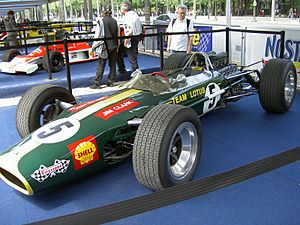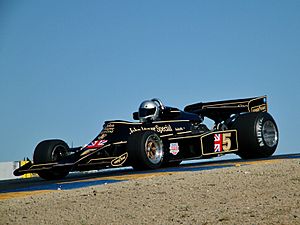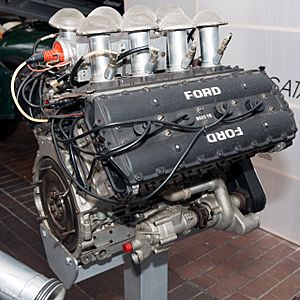Team Lotus facts for kids
 |
|
| Full name | Team Lotus |
|---|---|
| Base | Hethel, Norfolk, United Kingdom |
| Founder(s) | Colin Chapman |
| Noted staff | Maurice Philippe Peter Collins Peter Wright Peter Warr Mike Costin Keith Duckworth Gérard Ducarouge Frank Dernie Chris Murphy Andrew Ferguson |
| Noted drivers | |
| Formula One World Championship career | |
| Engines | Climax, BRM, Ford, Pratt & Whitney, Renault, Honda, Judd, Lamborghini, Mugen-Honda |
| Debut | 1958 Monaco Grand Prix |
| Races competed | 491 (489 starts) |
| Constructors' Championships | 7 (1963, 1965, 1968, 1970, 1972, 1973, 1978) |
| Drivers' Championships | 6 (1963, 1965, 1968, 1970, 1972, 1978) |
| Race victories | 74 |
| Podiums | 165 |
| Pole positions | 102 |
| Fastest laps | 65 |
| Final race | 1994 Australian Grand Prix |
| Formula One World Championship career | |
|---|---|
| Engines | Borgward, Coventry Climax, BRM, Maserati, Ford-Cosworth, Pratt & Whitney, Renault, Honda, Judd, Lamborghini, Mugen-Honda |
| Entrants | Team Lotus, Rob Walker Racing Team, numerous minor teams and privateers |
| First entry | 1958 Monaco Grand Prix |
| Last entry | 1994 Australian Grand Prix |
| Races entered | 491 entries (489 starts) |
| Race victories | 79 |
| Constructors' Championships | 7 (1963, 1965, 1968, 1970, 1972, 1973, 1978) |
| Drivers' Championships |
6 (1963, 1965, 1968, 1970, 1972, 1978) |
| Pole positions | 107 |
| Fastest laps | 71 |
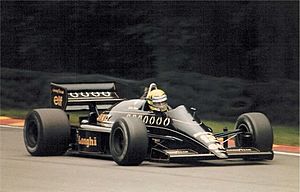
Team Lotus was a famous racing team from England. It was connected to the sports car company Lotus Cars. The team competed in many types of racing, like Formula One, Formula Two, and IndyCar.
Team Lotus was one of the most successful racing teams ever. It won seven Formula One Constructors' titles and six Drivers' Championships. They also won the Indianapolis 500 race in the United States. These wins happened between 1962 and 1978.
The team's founder, Colin Chapman, was a brilliant designer. Lotus was known for its new and experimental ideas in racing. They changed how race cars were built and how teams operated.
The Lotus name returned to Formula One in 2010 with a new team called Lotus Racing. Later, the famous black-and-gold colors of Lotus came back to F1. This was with the Lotus Renault GP team in 2011. By 2012, this team was fully renamed Lotus F1 Team.
Team Lotus was the last Formula One team that stopped racing to have won a Grand Prix and a World Constructors' Championship title.
Contents
Lotus's Early Days: The 1950s
Colin Chapman started Lotus Engineering Ltd in 1952 in Hornsey, UK. His early sports cars, like the 1953 Mk 6 and 1954 Mk 8, were very successful. Team Lotus became a separate racing team in 1954.
In 1958, the Lotus 12 race car appeared. Cliff Allison won an F2 race in a Lotus 12 that year. The Lotus Elite, a production car, also won many class victories in races like the 24 Hours of Le Mans.
Chapman decided to enter Grand Prix racing in 1958. He used Lotus 12s and later Lotus 16s. In 1960, he switched to the important mid-engined Lotus 18 car. The company grew so much that it moved to new buildings in Cheshunt.
Dominating the Track: The 1960s and 1970s
The first Formula One win for the official Lotus team happened in 1961. Innes Ireland won the 1961 United States Grand Prix. Before that, Stirling Moss had won a race in a Lotus car in 1960.
Lotus also had success in Formula Two and Formula Junior races. Their road cars, like the Lotus Seven and Lotus Elan, were also popular. The Lotus Cortina racing car won championships in 1963, 1964, and 1965.
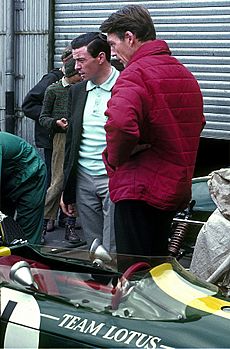
In 1963, Jim Clark drove the Lotus 25 to seven wins. He won the World Championship that year. In 1965, Clark dominated again, winning six races in his Lotus 33 and taking another championship.
Lotus cars were very innovative. However, some drivers faced challenges with the car designs. Several top drivers were injured or died while racing Lotus cars. Dan Gurney, another racer, noted that structural failures happened. He felt it was the price for having a much better car.
When F1 engines became three litres in 1966, Lotus was not ready. They struggled with engines until 1967. Then, they started using the new Ford Cosworth DFV engine. This engine was designed by former Lotus employee Keith Duckworth. It brought the team back to winning races.
In 1968, Lotus cars became dominant again with the Lotus 49 and the DFV engine. Sadly, Jim Clark died in a non-championship race that year. He was one of the most successful drivers ever. The 1968 season also saw the introduction of wings on F1 cars. Lotus was the first F1 team to use wings. Graham Hill won the F1 World Championship in 1968 driving the Lotus 49.
Around this time, Colin Chapman moved Lotus to a new factory in Hethel, Norfolk. The old runways of a former air base became a testing track.
In 1970, Lotus introduced a revolutionary new car, the wedge-shaped Lotus 72. This car had many new features, like special suspension and radiator placement. After some early issues, the car became very fast. Jochen Rindt dominated the championship. Sadly, he died in an accident during a race. Rindt became the only driver in history to win the world championship after his death.
For 1972, Lotus focused on the Type 72 chassis again. They got new sponsorship from John Player Special. The cars were now black and gold. In 1972, 25-year-old Brazilian driver Emerson Fittipaldi became the youngest world champion at the time. Team Lotus also won the F1 World Championship for Manufacturers for the sixth time in 1973. The Lotus 72 raced for five years and was very successful.
Chapman also had success in the Indianapolis 500 race. In 1963, the Lotus 29 almost won. In 1965, Jim Clark won the Indianapolis 500 in his Lotus 38. This was the first time a mid-engined car won that race.
Many of Chapman's successes came from his new ideas. The Lotus 25 was the first F1 car with a monocoque chassis. The Lotus 49 was one of the first to use the engine as a strong part of the car's structure. The Lotus 72 brought new ideas in aerodynamics.
Chapman also changed how racing teams worked. In 1968, the FIA allowed teams to have sponsors. Team Lotus was one of the first factory teams to paint their cars in their sponsor's colors. They used the red, gold, and white colors of Gold Leaf tobacco.
In 1973, Team Lotus became the first F1 constructor to win 50 Grand Prix races.
In the mid-to-late 1970s, Lotus became strong again with Mario Andretti joining the team. Engineers started looking into aerodynamic ground effects. The Lotus 78 and Lotus 79 cars were very successful. Mario Andretti won the F1 World Championship in 1978. Lotus tried to improve ground effects even more with the Lotus 80 and Lotus 88. Chapman also started working on a new active suspension system. He died in December 1982.
The 1980s: New Drivers and Challenges
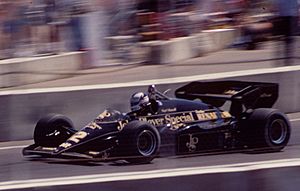
After Colin Chapman's death, his wife, Hazel, and manager Peter Warr continued the team. However, their F1 car designs were not as successful. In 1983, Lotus hired designer Gérard Ducarouge. He quickly built the Renault turbo powered 94T. In 1984, Elio de Angelis finished third in the World Championship. The team also finished third in the Constructors' Championship.
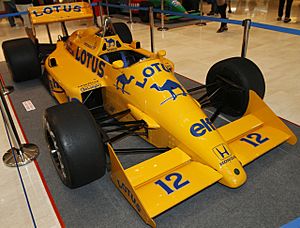
When Nigel Mansell left, the team hired Ayrton Senna. The Lotus 97T won races with de Angelis and Senna in 1985. Senna got eight pole positions and two wins in 1986 with the Lotus 98T. Lotus finished third in the Constructors' Championship.
At the end of 1986, Lotus got new sponsorship from Camel. Senna's talent attracted Honda engines to the team. Lotus agreed to have Satoru Nakajima as their second driver. The 99T car, designed by Ducarouge, had active suspension. Senna won two races in 1987. The team finished third in the Constructors' Championship again.
Senna moved to McLaren in 1988. Lotus signed Nelson Piquet, who was then World Champion. Piquet and Nakajima did not win any races. However, the team still finished fourth in the Constructors' Championship. McLaren, using the same Honda engines, won 15 of 16 races that year. Lotus struggled to keep up.
The Lotus-Honda 100T was not successful. Ducarouge left in 1989. Lotus then used Judd V8 engines. Piquet finished fourth in three races that year. At the end of 1989, Piquet left for Benetton.
The 1990s and the End of an Era
For 1990, Lotus used Lamborghini V12 engines. Derek Warwick and Martin Donnelly were the drivers. The car was not successful. Warwick scored only a few points. Donnelly had a serious accident. At the end of the year, Camel stopped their sponsorship.

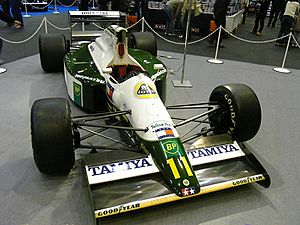
Former Team Lotus employees Peter Collins and Peter Wright took over the team. In 1991, the new Team Lotus started with Mika Häkkinen and Julian Bailey. They drove updated Lotus 102Bs with Judd engines. The team scored double points at the 1991 San Marino Grand Prix. Bailey was later replaced by Johnny Herbert.
For 1992, the team used Ford's HB V8 engines in their new Lotus 107 cars. The team had little money, which affected performance. Still, Häkkinen scored 11 points, including two fourth places. Herbert scored two points. The team finished fifth in the Constructors' Championship. Häkkinen moved to McLaren in 1993. He was replaced by Alessandro Zanardi. Zanardi was later replaced by Pedro Lamy after an accident. Herbert scored the last two points for Team Lotus that year. The team finished sixth in the 1993 Constructors' Championship.
Debts grew, and the team could not develop the Lotus 107. For the 1994 season, they used Mugen Honda engines. Herbert and Lamy struggled with the old car. Lamy was seriously injured in a testing accident, and Zanardi returned. The team's new car, the Lotus 109, was introduced later in the season.
The team faced financial difficulties. They hired pay-driver Philippe Adams for some races. At the 1994 Italian Grand Prix, Herbert qualified well in the 109. However, he was forced off the track at the start. The team then sought protection from its creditors. Tom Walkinshaw bought Johnny Herbert's contract.
The company was officially closed down in February 1995. Before the end of the 1994 season, the team had been sold to David Hunt. Work on a new car, the Lotus 112, stopped. In February 1995, Hunt announced a partnership with Pacific Grand Prix. Team Lotus officially ended. Pacific Grand Prix was briefly called Pacific Team Lotus.
Pacific left Formula One after the 1995 Australian Grand Prix. The last race for Team Lotus was the 1994 Australian Grand Prix.
The Lotus Name Returns to Formula One in 2010
After Team Lotus closed in 1994, David Hunt bought the rights to the name. In 2009, there were plans for a new team to enter F1 using the Lotus name. Lotus Cars, the original company's sister, did not support this.
In September 2009, a Malaysian-backed team called Lotus Racing was allowed to join the 2010 season. Later, Lotus Cars ended their agreement with this team. On September 24, 2010, Tony Fernandes (from Lotus Racing) bought the Team Lotus name rights from David Hunt. This meant the official Team Lotus name was back in F1.
Then, on December 8, 2010, Genii Capital and Group Lotus plc announced "Lotus Renault GP." This team was the successor to the Renault F1 Team. It would race in 2011. This meant there would be two teams using the Lotus name that season. Fernandes's team had the "Team Lotus" name. Lotus-Renault was supported by Group Lotus plc.
On May 27, 2011, a court decided that Tony Fernandes could use "Team Lotus" for his F1 team. The court also said that Group Lotus could use the "Lotus" name in F1 and for road cars. So, in the 2011 Formula One season, there were two teams with "Lotus" in their names.
In 2012, Lotus Renault GP got the rights to the Lotus name and was renamed Lotus F1. Fernandes's team was renamed Caterham F1. The Lotus F1 team raced for four seasons. Then, it returned to being the French constructor Renault.
Formula One Results
See also
 In Spanish: Team Lotus para niños
In Spanish: Team Lotus para niños


